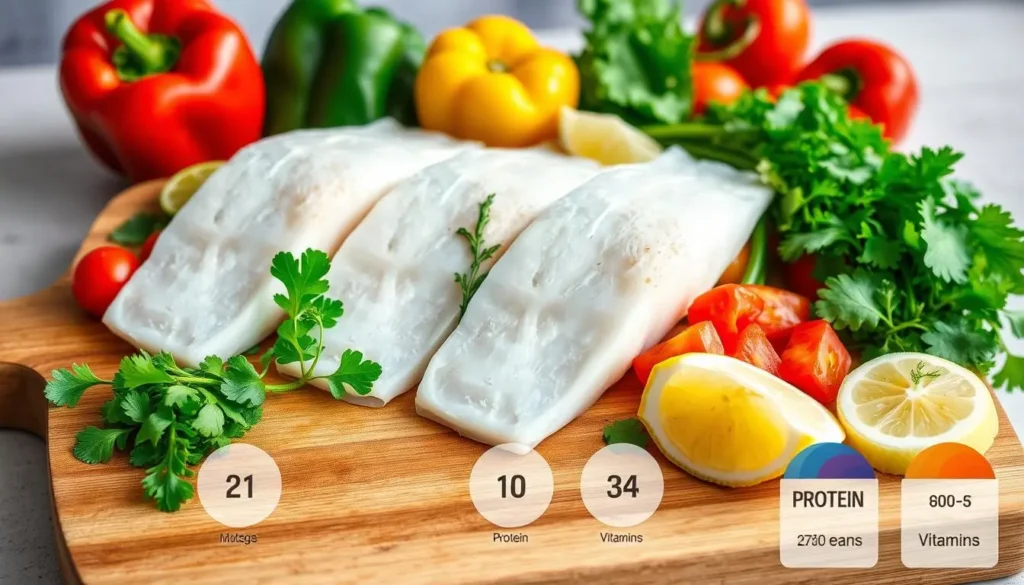Is halibut a good fish?
Are you curious about halibut, the white-fleshed fish loved by chefs and seafood fans? This article explores its benefits and nutrition. It helps you decide if halibut is right for your meals.
Halibut is known for its firm texture and sweet taste. It’s a top choice for many. But it’s also great for your health. Learn why halibut is good for you and how it can improve your well-being.
Key Takeaways
- Halibut is a premium, white-fleshed fish prized for its firm, flaky texture and delicate, sweet flavor.
- Halibut is an excellent source of high-quality protein, essential vitamins, and beneficial omega-3 fatty acids.
- Consuming halibut can provide a range of health benefits, including heart health support, brain function enhancement, and weight management assistance.
- Proper cooking techniques and storage methods are crucial to preserving the delicate texture and flavor of halibut.
- Halibut is a versatile and sustainable seafood option that can be enjoyed in a variety of delicious recipes, from grilled fillets to tasty fish tacos.
What Makes Halibut a Premium Fish Choice
Halibut is a top pick among seafood lovers. It’s found in the Pacific and Atlantic Oceans. Its unique qualities make it a standout in the kitchen.
Distinguished Features of Pacific Halibut
The Pacific halibut can grow really big, over 500 pounds. It has a firm texture and a sweet taste. Pacific halibut is great for many cooking styles, like grilling and baking.
Atlantic Halibut Characteristics
The Atlantic halibut may not be as big as the Pacific one. But it still offers a great taste experience. It has a sweet flavor and a flaky texture. Atlantic halibut is smaller, making it easier for home cooks to handle.
Wild-Caught vs. Farm-Raised Halibut
- Wild-caught halibut is loved for its high quality and health benefits. It’s free from additives and contaminants found in farm-raised fish.
- Farm-raised halibut is more affordable and consistent. It’s a good choice for those on a budget.
Choosing between wild-caught and farm-raised halibut depends on what you prefer. Both are tasty and healthy for any meal.
Nutritional Profile of Halibut
Halibut is a very nutritious fish, full of vitamins, minerals, and healthy fats. Looking at the halibut nutrition facts, it’s easy to see why it’s so popular.
Halibut is known for its high protein content. A 3.5-ounce serving has about 26 grams of protein. This is great for building and repairing muscles.
Halibut also has a lot of omega-3 fatty acids. These fats are good for your heart, reduce inflammation, and help your brain work better. You get over 1 gram of omega-3s from just one serving.
| Nutrient | Amount per 3.5 oz Serving | % Daily Value |
|---|---|---|
| Calories | 155 | 8% |
| Protein | 26g | 52% |
| Omega-3 Fatty Acids | 1.1g | N/A |
| Vitamin B12 | 2.0 mcg | 33% |
| Selenium | 47.9 mcg | 87% |

Halibut Nutrition Facts
Halibut is a nutrient-rich fish that offers many health benefits. It is a great source of vitamin B12, which is essential for making red blood cells and maintaining brain function. Additionally, halibut contains selenium, an antioxidant that protects cells from damage.
With its high nutritional value, halibut is considered a top choice for seafood lovers. It is an excellent source of protein, which supports heart health and overall well-being. Including halibut in your diet can be a smart choice for a healthy lifestyle.
Essential Health Benefits of Eating Halibut
Eating halibut can significantly improve your health. It is a fish that is rich in nutrients, beneficial for both your heart and brain. It also aids in weight management.
Heart Health Advantages
Halibut is packed with omega-3 fatty acids, which are crucial for a healthy heart. These fats help lower inflammation, blood pressure, and cholesterol levels.
This reduces the risk of heart disease and stroke. Regular consumption of halibut is beneficial for your heart health.
Brain Function Support
The omega-3s in halibut are also beneficial for brain function. They enhance brain function, memory, and focus. Including halibut in your meals can help keep your brain sharp.
Weight Management Benefits
- Halibut is low in fat but high in protein, making it ideal for maintaining a healthy weight or aiding in weight loss.
- Its protein content helps you feel full, reducing the urge to overeat.
- The omega-3s in halibut also aid in fat burning, supporting weight control.
Adding halibut to your diet offers numerous health benefits. It is beneficial for your heart, brain, and weight management. It is a key component of a balanced diet for overall health.
Is Halibut a Good Fish? Understanding Its Value
Halibut is considered one of the best white fish options. It is known for its high quality, nutritional value, and eco-friendly fishing practices. This makes it a favorite among seafood enthusiasts.
Halibut has a firm texture and a mild taste. It is versatile and can be grilled, baked, or pan-seared. This fish offers a premium eating experience that surpasses cod or tilapia.
Halibut is also packed with nutrients. It is a rich source of protein, vitamins, and omega-3 fatty acids. Consuming halibut can benefit your heart, brain, and weight.
Moreover, halibut is a sustainable seafood choice. It is caught in a manner that is environmentally friendly. This ensures the long-term health of its populations.
In summary, halibut is a superior white fish. It tastes great, is nutritious, and is caught responsibly. It is an excellent choice for anyone who enjoys seafood.
Best Cooking Methods for Halibut
Halibut is a versatile fish that can be prepared in various delicious ways. You can grill, bake, or pan-sear it. Each method highlights the fish’s natural sweetness and firm texture.
Grilling and Baking Techniques
For a classic grilled halibut, season the fillets with your favorite herbs and spices. Grill them over medium-high heat for 8-10 minutes, flipping halfway. Baking is also great, as it keeps the fish moist and flavorful.
Preheat your oven to 400°F. Place the halibut fillets on a greased baking sheet. Bake for 12-15 minutes, or until the fish flakes easily with a fork.
Pan-Searing Tips
Pan-searing is a quick and easy way to cook halibut. Pat the fillets dry and season with salt and pepper. Heat a tablespoon of oil in a large skillet over medium-high heat.
Once the oil is shimmering, add the halibut fillets. Sear the fish for 3-4 minutes per side, until a golden-brown crust forms. This method locks in the juices, making the grilled halibut or baked halibut tender and delicious.
| Cooking Method | Time | Temperature | Technique |
|---|---|---|---|
| Grilling | 8-10 minutes | Medium-high heat | Flip halfway through |
| Baking | 12-15 minutes | 400°F | Preheat oven, place on greased baking sheet |
| Pan-Searing | 3-4 minutes per side | Medium-high heat | Pat fillets dry, season with salt and pepper |
Learning these cooking methods lets you fully enjoy how to cook halibut. You’ll love its delicate taste and flaky texture in many dishes.

How to Select and Store Fresh Halibut
When buying fresh halibut, look for certain signs. The fish should have firm flesh and a shiny, clear look. Avoid halibut that looks dull, has off colors, or smells too fishy. Also, the eyes should be bright and clear, and the gills should be a vibrant red or pink.
After picking the freshest halibut, store it right. Wrap it tightly in plastic or use an airtight container. Keep it on ice or in the coldest part of your fridge, usually the bottom shelf. This way, it can stay fresh for up to 3 days. If you want to keep it longer, freeze it. It will stay good for 6-8 months, keeping its freshness and flavor at their best.
Following these fish freshness tips is key to enjoying great halibut. With the right choice and storage, you’ll get to enjoy its tender texture and rich taste. This premium seafood is a treat for your taste buds.
Making Perfect Halibut Fish Tacos
Halibut is a top choice for fish tacos. It has a firm, flaky texture and a mild taste. This makes it perfect with the bright toppings and sauces that make fish tacos so great.
Essential Ingredients
To make the best halibut fish tacos, you’ll need a few key things:
- Fresh halibut fillets, cut into bite-sized pieces
- Corn or flour tortillas
- Shredded cabbage or lettuce
- Diced tomatoes
- Sliced avocado
- Chopped cilantro
- Lime wedges for serving
White Sauce Recipe and Variations
A creamy white sauce is key for your halibut fish tacos. Here’s a simple recipe:
- In a small bowl, mix together 1 cup of mayonnaise, 1/4 cup of sour cream, 2 tablespoons of lime juice, and a pinch of salt and pepper.
- For a zestier flavor, add a tablespoon of finely chopped jalapeño or a teaspoon of chili powder.
- For a tangier sauce, use plain Greek yogurt instead of sour cream.
The white sauce is a great match for the mild halibut fish tacos. It adds to the fresh, vibrant flavors of your taco.
With the right ingredients and a creamy white sauce, you can make the best fish tacos with halibut. It’s one of the most premium white fish options out there.
Sustainable Fishing Practices and Halibut Conservation
As a conscious consumer, you play a key role in supporting sustainable halibut fishing and conservation. Halibut is a favorite seafood, but it’s vital to choose responsibly. This ensures your purchases support eco-friendly practices.
Pacific halibut has seen a lot of conservation work. The International Pacific Halibut Commission (IPHC) watches over halibut populations. They set strict catch limits to keep halibut sustainable for the future.
| Sustainable Halibut Fishing Practices | Halibut Conservation Efforts |
|---|---|
| Adhering to catch quotas and size limits Using selective fishing gear to minimize bycatch Avoiding overfishing and respecting spawning seasons | Extensive stock assessments by the IPHC Collaborative efforts between fishermen and regulators Habitat protection and research on halibut biology |
When picking seafood, look for the Marine Stewardship Council (MSC) label. It shows the halibut was caught sustainably. Choosing responsibly sourced halibut lets you enjoy it while helping the ocean.
“Sustainable fishing practices are essential to ensure that future generations can continue to enjoy the bounty of the ocean.”
Your choices as a consumer matter a lot. By choosing responsibly sourced halibut, you get a delicious meal. You also help protect our oceans for the future.
Common Mistakes to Avoid When Preparing Halibut
Cooking halibut can be fun. But, it’s important to avoid common mistakes. Knowing about temperature control and seasoning can help you cook better halibut.
Temperature Control Tips
Keeping the right temperature is key when cooking halibut. Overcooking can make it dry and tough. Here’s how to cook it just right:
- Aim for an internal temperature of 130-135°F (54-57°C) for a moist, flaky texture.
- Use a reliable meat thermometer to monitor the temperature and avoid guesswork.
- Be mindful of carryover cooking, as the halibut will continue to cook even after it’s removed from the heat.
Seasoning Guidelines
Seasoning is key to bring out the natural flavors of halibut. Don’t overdo it with too many spices or sauces. Here are some seasoning tips:
- Use a light hand with salt and pepper, allowing the fresh, clean taste of the halibut to shine.
- Experiment with complementary herbs and citrus, such as dill, lemon, or a touch of garlic.
- Resist the temptation to smother the halibut in heavy, creamy sauces, which can mask its natural flavors.
Mastering temperature control and seasoning will help you make halibut dishes that look great and taste amazing.
Comparing Halibut to Other White Fish
Choosing the right white fish can be tough. Halibut, cod, and tilapia are all favorites, each with its own special qualities. Let’s look at what makes them different.
Nutritional Value
Halibut is a standout for its health benefits. It’s lean, packed with protein, and low in bad fats. It also has lots of vitamins and minerals. Compared to cod, halibut has more omega-3s, which are good for your heart.
Tilapia has less omega-3s, so halibut is better for your heart health.
Taste and Texture
Halibut is known for its sweet taste and firm texture. Cod is also mild but flakier. Tilapia is a bit cheaper and has a softer texture.
Culinary Versatility
Halibut is great for grilling, baking, or pan-searing because of its firm texture. It can handle strong flavors well. Cod and tilapia are also versatile but need a gentler touch in cooking.
| Characteristic | Halibut | Cod | Tilapia |
|---|---|---|---|
| Nutritional Value | High in protein, omega-3s, and vitamins/minerals | Lean protein, lower in omega-3s | Lean protein, lower in omega-3s |
| Taste and Texture | Delicate, sweet flavor; firm, flaky texture | Mild, delicate flavor; flaky texture | Mild, slightly more pronounced flavor; tender, soft texture |
| Culinary Versatility | Excellent for grilling, baking, and pan-searing | Versatile, but may require a gentler approach | Versatile, but may require a gentler approach |
Halibut, cod, and tilapia each have their own strengths. Halibut is top-notch for its health, taste, and texture. Cod and tilapia are more affordable but still great for cooking. Think about what you like and what you’re making to pick the best white fish.

Seasonal Availability and Best Time to Buy
Enjoying fresh halibut is all about timing. Halibut is a white fish known for its firm texture and mild flavor. It has a specific season when it’s best to buy.
The halibut season is from spring to early fall. The summer months are when fresh halibut availability is highest. This is the perfect time to enjoy it.
The best time to buy halibut is between May and September. You’ll find halibut that’s been caught recently. This ensures it’s at its freshest and tastiest.
“Halibut is a versatile and nutritious fish that deserves a spot on your plate throughout the summer months.”
Halibut can still be found outside of summer, but the quality may vary. Knowing when halibut is in season helps you get the best.
Whether you’re grilling, baking, or pan-searing, buying halibut at the right time is key. It makes all the difference in its flavor.
Conclusion
In this article, we’ve looked at the amazing benefits of halibut. It’s a top-notch white fish that’s great for you. It’s packed with nutrients and offers many health perks.
Halibut is not just good for you; it’s also delicious. You can cook it in many ways. It’s perfect for those who want to eat healthy and tasty food.
Choosing halibut means you’re picking a fish that’s good for the planet. It’s full of vitamins, minerals, and protein. Eating halibut can make your heart and brain healthier.
To get the most out of halibut, pick the right one and store it well. Follow the tips in this article to cook it perfectly. Try halibut today and enjoy its flavor and health benefits.
FAQ
What is the best kind of fish to use for fish tacos?
Halibut is a top pick for fish tacos. It has a firm, flaky texture and a mild, sweet taste. This makes it a premium choice that pairs well with taco ingredients. Plus, halibut is versatile and cooks well in various ways, perfect for tacos.
Do you skin halibut before cooking?
Yes, it’s best to remove the skin from halibut before cooking. The skin can get tough and chewy, which isn’t great for the fish’s texture. Removing the skin ensures the halibut fillet stays smooth and delicate in your tacos.
What is the white sauce on fish tacos made of?
The creamy white sauce in fish tacos is a mix of mayonnaise, sour cream, lime juice, and spices. It’s tangy and cool, contrasting nicely with the warm fish and crunchy toppings. You might find garlic, cilantro, and a bit of heat from hot sauce or spices added in.
How do you cook halibut for fish tacos?
Cook halibut quickly over high heat to keep it moist and flaky. You can pan-sear, grill, or bake it. Just remember, don’t overcook it to avoid dryness.
Seasoning with spices, herbs, or a citrus marinade can enhance the flavor. This makes your fish tacos even more delicious.
What is the best way to store fresh halibut?
To keep halibut fresh, store it correctly. Wrap fillets or steaks tightly in plastic or seal in an airtight container. Place them on ice or in the fridge’s coldest spot.
Use the halibut within 2-3 days for the best taste and texture. This way, you’ll enjoy it at its freshest.

